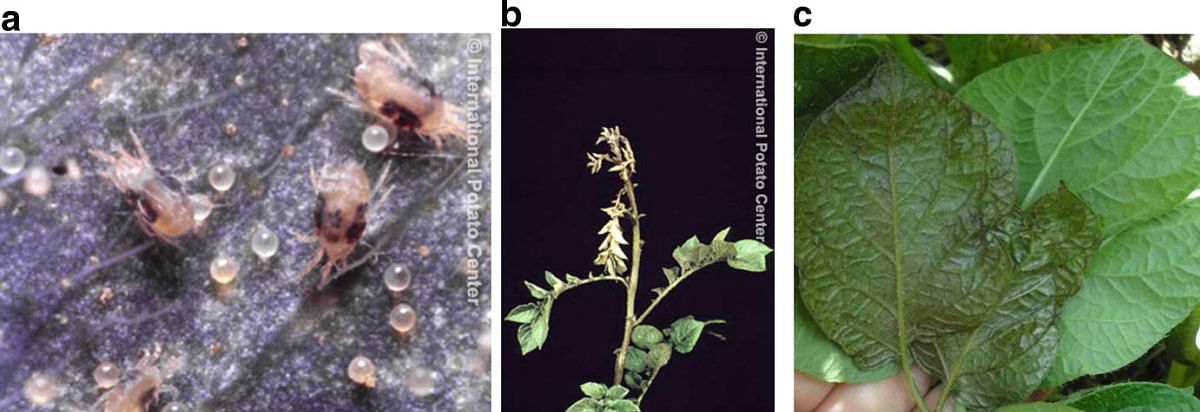Scientific description of Mites (2020)
Based on J. Kroschel. et al. (2020) Insect Pests Affecting Potatoes in Tropical, Subtropical, and Temperate Regions. In: Campos H., Ortiz O. (eds) The Potato Crop. Springer, Cham
The authors of this content are Jürgen Kroschel, Norma Mujica, Joshua Okonya, Andrei Alyokhin
Tetranychus urticae C. L. Koch, T. evansi Baker & Prichard, Polyphagotarsone-mus latus (Banks) (Arachnidae: Trombidiformis, Tarsonemidae)
Distribution
The origin of the tomato or tobacco red-spider mite Tetranychus evansi is Brazil. The pest was accidentally introduced into Southern Africa during the 1980s. The two spotted- or red-spider mite Tetranychus urticae and the broad mite Polyphagotarsonemus latus are widely distributed in both tropical and subtropical areas of the world (CABI 2017g, h) (image below).

Tetranychus urticae feeding on a potato leaf (a), and symptoms of white mite feeding causing deformation of buds and tender leaves (b) and toasted appearance on the underside of a potato leaf (c). (Courtesy: CIP)
Host range
Mites are polyphagous. Major hosts are potato, tomato, tobacco, pepper, eggplant, pumpkins and squashes (Cucurbita pepo L.), cucumber, watermelon, celery, maize, beans, strawberry (Fragaria × ananassa), cotton, citrus, papaya (Carica papaya L.) (Hazzard 2013; Landis and Davis 1947; Goftishu et al. 2016).
Symptoms of infestation
T. urticae and related mites are generally known as red spiders, although red is not always their characteristic color. Mites are extremely small, almost microscopic, and feed on the cellular matter of leaves. Chlorotic spots caused by mites give leaves a tan coloring, whereas high infestation will cause leaf and plant wilting. P. latus attacks sprouts and tender leaves, deforming them.
Damage to growing plants is particularly severe. The white mite colonies are located on the underside of the young leaves and on the buds. The infested plants take a dark to moderate green coloration and develop a somewhat leathery appearance.
Heavy infestation may result in plant death (CIP 1996; Larrain et al. 2003; Sanchez and Vergara 2002; Landis and Davis 1947).
Impacts on production losses
Plants with severe damage of P. latus do not form tubers and remain very small. When infestations occur in an intense and violent way they can cause the destruction of entire crop field. In the same way, attack by hundreds or thousands of red spider mites can cause thousands of lesions, thus can significantly reduce the photosynthetic capability of plants (CIP 1996; Larrain et al. 2003; Sanchez and Vergara 2002).
Methods of prevention and control
- Monitoring.
Mite infestations normally begin at boundaries of the potato fields especially those neighboring fields of preferred host plants such as maize, alfalfa, and mint. Stressed potato plants tend to be more susceptible.
Mites can build high populations in a very short time during hot (above 30 °C) dry seasons. Constant visual monitoring and early detection is key. Check on the underside of leaves that show symptoms of nutrient deficiency (CABI 2017g, h). - Cultural practices.
Sprinkler irrigation helps to limit mite damage by increasing the humidity (above 60%) on plant leaves, thus making conditions less favorable for mites. Proper field sanitation is done through removal of infested plants and volunteer crops (CIP 1996; CABI 2017g, h). - Natural control.
Often mites are kept under control by their natural enemies, including predatory thrips, lacewings, gall midges (Feltiella acarisuga Vallot) and ladybird beetles (Stethorus punctillum Weise) and predatory mites (Phytoseiulus persimilis Athias-Henriot, Neoseiulus californicus (McGregor), Amblyseius andersonii Berlese, Galendromus occidentalis Nesbitt, Mesoseiulus longipes, and Hypoaspis miles Berlese (Pundt 2007).
Mites become primary pest when natural enemies are destroyed by insecticide applications to control other insect pests. So, avoid use of nonselective pesticides which reduce predatory mite populations. - Biopesticides.
Plant extracts such as azadirachtin (neem oil), or from cotton seed, soybean, clover, garlic, rosemary (Rosemarinus officinalis L.), and pyrethrum have shown some efficacy against red spider mites (CABI 2017g, h). - Chemical control.
When control measures are required, usually a single application of an acaricide is sufficient especially when populations are still low (less than five mites per plant). In some cases, focal treatments are recommended using either soap, sulphur, Bifenazate, abamectin, spirotetramat, and spiromesifen (Hazzard 2008).
